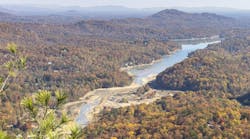The city of Golden, British Columbia, Canada, asked itself how it could start a green initiatives program without breaking the budget of a small town with a population of less than 4,000. Often, green and sustainable programs can be expensive, labor-intensive, require outside engineering expertise and hit roadblocks in local building codes. Driven by the Development Services Department (DSD), the city of Golden devised a way to turn an eyesore—a vacant gravel parking lot—into a model of small-town ingenuity. The DSD chose to develop the vacant lot into a porous paving parking lot with storm water mitigation and other sustainable properties.
St. Andrews United Church and Center for Peace donated the land to the city of Golden. The partnership between the two entities has worked well: The city was able to showcase its willingness to go green, and the church received a well maintained parking lot for its parishioners. There are two designated handicapped parking bays and one designated church parking space, and the rest of the spaces are open to the general public.
Restaurant patrons, the industrial sector and the church all use the parking lot, which is comprised of two types of permeable pavers, gravel contained and grass supported. The gravel porous pavement was used in the main drive aisles of the parking area, and grass reinforcement was used in the parking bays and some of the perimeter.
Natural Percolator
The porous system allows rain and snowmelt to percolate through its cross-sections and back into the groundwater supply. This mimics the natural water cycle of undeveloped land. The porous pavers also filter out hydrocarbon drips from the automobiles, animal waste and moderate amounts of solid waste, delivering clean water to the groundwater supply. These contaminants otherwise would be suspended in the runoff water from an asphalt, concrete or conventional compacted gravel surface and subsequently pollute downstream water supplies.
Grasspave2 and Gravelpave2 porous paving products, manufactured by Invisible Structures Inc. , were chosen for the new green parking lot. The products are comprised of a series of cylinders on a grid system designed to disperse the load to an engineered porous base course. The Gravelpave2 product is filled with clean, small aggregate, and the Grasspave2 is filled with sand and topped with sod.
Rob De Kleer, development technician for the city of Golden, was responsible for the drainage and layout plan. De Kleer designed a dry well with a storm drain in the center of the lot, with the permeable paving graded to drain into the well in events during which the percolation could not keep up with the runoff. “We designed in some redundancy since this was our first experience,” De Kleer said.
Aaron Rennie of Brock White, based in Calgary, was on site to oversee the four-person installation city crew. “We were done in the better part of three days,” Rennie said.
According to Rennie, the only setback was anchoring the Gravelpave2. The anchor nails were hitting the storm drain inlet in the center of the parking lot. “We just had to move them over a bit,” he said.
The lot was installed in the summer of 2010, so Golden is experiencing its first winter with the new environmentally friendly lot.
Chris Cochran, operations manager for the city of Golden described the parking lot as a test for the city and the climate. Golden receives about 67 in. of snowfall and 12 in. of rainfall annually.
“We’ve been back-blading and scooping, leaving a small pack of snow, which seems to be working fine,” Cochran said. He also anticipates that city staff may have to examine the lot when temperatures reach above freezing. “We may shut it down [to the public] to see the effects,” he said, noting a desire to see how the thaw and spring melt patterns affect the lot.
Another aspect of the partnership between the church and the city allows for church members to use the perimeter of the parking lot for community gardens. “We love it,” said Minister Judith Hardcastle of St. Andrews United Church and Center for Peace. “It worked out very well.”

